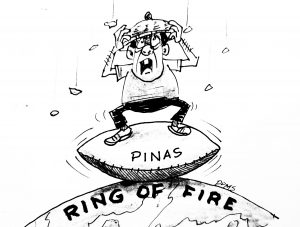Authorities in the country have been preparing us for a ‘big one’, or a massive, devastating earthquake that could strike us at any moment. But instead of just one, a series of major earthquakes have been hitting us in a row, almost every week. These seismic events are characterized by their high magnitude, causing widespread destruction and loss of life.
Indeed, major earthquakes have been hitting the Philippines recently. The country lies in the Pacific Ring of Fire, an area prone to seismic activity. Rapid urbanization and inadequate infrastructure contribute to the vulnerability of our archipelago. Consequently, we should prepare for the consequences of these earthquakes and propose measures to mitigate their impact. We should brace not just for a big one, but for a series of big ones, it seems.
The causes of earthquakes in the Philippines can be attributed to its geographical location along the tectonic boundaries. The Philippine Sea Plate and the Eurasian Plate converge. This convergence leads to seismic activities as the plates collide, resulting in significant earthquakes. The underlying geology of the country makes it prone to intense ground shaking and potential tsunamis. We should then recognize the geological processes causing earthquakes in the region and the vulnerabilities of densely populated areas.
The impacts of these major earthquakes can be severe, as witnessed in recent events. Most notably, the series of earthquakes that struck Mindanao caused many casualties and extensive damage to infrastructure. With numerous buildings and infrastructure systems not designed to withstand such intense shaking, the vulnerability of densely populated areas exacerbates the consequences. Moreover, the destruction of critical facilities such as hospitals, schools, and water distribution systems further hampers recovery efforts.
To mitigate the impact of earthquakes on the Philippines, several measures should be considered. Firstly, there is a need for improved urban planning and stricter building codes. Enforcing seismic design standards while considering local geological conditions is vital to ensure the construction of resilient infrastructure. Additionally, investing in early warning systems can provide crucial seconds to minutes of advance notice, enabling people to take cover or evacuate. Developing public awareness campaigns and conducting earthquake drills are equally important to educate communities and enhance preparedness.




